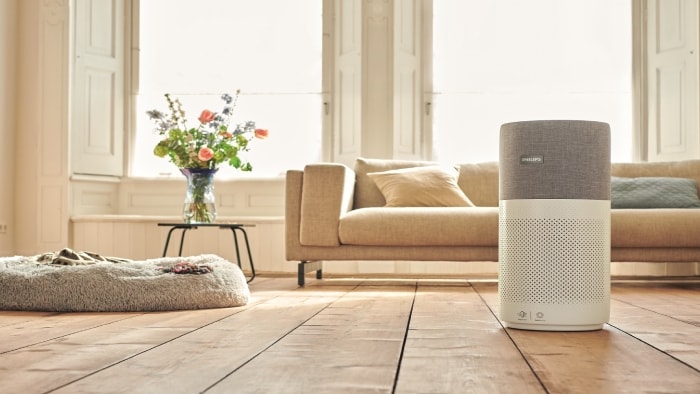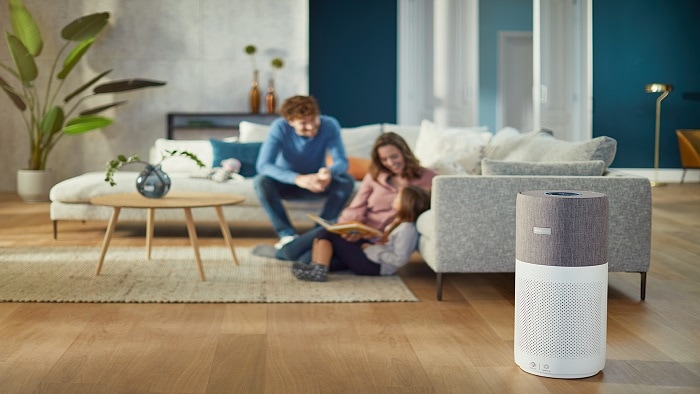Oct 27, 2020
Philips Steps Up its Innovation Efforts in Air Purification To Improve Indoor Air Quality
KUALA LUMPUR, MALAYSIA – Royal Philips (NYSE: PHG, AEX: PHIA), a global leader in health technology is stepping up its innovation efforts in air purification towards helping more people make the change to living healthier indoors the new normal. With a team of more than 100 scientists, doctors and engineers working in air purification, Philips has a long-standing heritage in health tech and has become a global leader in air purification. As part of this journey, Philips has launched its latest home care innovation – the new Philips Air Purifier 3000i Series – to help improve clean air delivery that keeps pollutants, bacteria and viruses at bay. Indoor air is 2 - 5 times more polluted than outdoor air[1] and is often compromised by PM2.5 ultrafine particles, allergens, bacteria, harmful gases as well as air humidity. Numerous forms of indoor air pollution lurk in modern indoor spaces, giving rise to chronic health conditions such as asthma or allergic rhinitis that affects more than 20% of the world’s population today[2]. According to the US Centers for Disease Control and Prevention (CDC)[3], there has been evidence that “some COVID-19 infections can be spread by exposure to viruses in small droplets and particles that can linger in the air for minutes to hours”, referring to airborne transmission. Lancet[4] has also stated that “proper conditions indoors have the potential to reduce the spread of COVID-19; conversely, improper conditions, such as limited ventilation and filtration, can make indoor environments high-risk settings.” Philips air purifiers remove up to 99.9% of aerosols from the air that passes through the filter, which may contain viruses. Philips air purifiers also can remove 99.97% of particles as small as 0.003μm (equal to 3 nm), smaller than the smallest known virus[5] from the air which passes through the filter, creating a healthy and safe indoor environment. A similar performance is expected for SARS-CoV-2 (COVID-19) aerosols. Philips is catering to the increasing consumer demand for innovative solutions to reduce risk of airborne transmission of respiratory droplets as more people become conscious of air quality and seek preventative measures such as social distancing, mask-wearing and enhancing personal hygiene protocols to live healthier.
Malaysians are increasingly prioritizing their health and those of their loved ones. At Philips, we believe that empowering people to take control of their own health is important, and can be addressed with innovative technologies,” said , “With the Philips Air Purifiers, we want to provide our customers with the latest intelligent, personalized solutions that can help them breathe easier by creating healthy indoor spaces.”
Nicholas Lee
Personal Health Leader, Philips ASEAN Pacific.
Creating healthy environments with intelligent, personalized solutions designed for modern indoor spaces Philips’ latest air purifier innovation– the Philips Air Purifier 3000i Series – presents an effective and innovative solution for healthy, clean, pollutant-free air in real time and a more powerful, hygienic and complete clean to increase ventilation and particle filtration. The Philips Air Purifier Series is designed for modern indoor environments such as homes, offices, clinics and schools that have little circulation of fresh air and are often dependent on air-conditioning for ventilation. The Philips Air Purifier Series uses the same HEPA filtration technology as those used in many hospitals to better protect patients and doctors from airborne viruses and bacteria. According to Asthma Malaysia, the chronic respiratory condition affects up 15% of adults and almost a quarter of all children in Malaysia[6]. A local study among children in Kuala Lumpur discovered that patients with asthma are more sensitive when exposed to indoor allergens such as dust mites compared to outdoor allergens, and can exacerbate the condition[7]. With the Philips Air Purifier 3000i Series, Philips is presenting the innovative superiority of its expert solutions for cleaner, healthier indoor spaces.
Philips Air Purifier 3000i Series Regular Retail Price: MYR1,999 Every breath matters with the Philips Air Purifier 3000i Series which senses harmful particles, gases and allergens in real time with a professional grade sensor that detects indoor pollutants such as pollen, dust mites, mold spores and pet dander. It has a superior filtration performance which can remove 99.97% of particles as small as 0.003um (800 times smaller than PM2.5 or smaller than the smallest known virus)[8]. The Philips Air Purifier Series can reduce the levels of Influenza (H1N1) virus aerosols by 99.9% from air passing through the filter[9]. Philips AeraSense technology continuously monitors the air and can purify air in a room of 20m2 in less than eight minutes[10]. It is highly effective in sensing even the slightest change in indoor air quality display which gives you reassurance. It uses an integrated filter model which is FY3430/30. It also provides effortless control and convenience with a Clean Home+ app, allowing you to check the air quality at home anytime. Additionally, real time air quality at a glance allows you to easily identify the indoor allergen index, PM2.5 and harmful gases level with different LED display options. The Philips Air Purifier 3000i Series also provides effortless maintenance with a smart filter that detects the amount of pollutants filtered, calculates filter lifetime and prompts for filter replacement. It has an innovative design with fabric texture finishing that blends in seamlessly with modern interiors. Its ultra-quiet sleep mode for clean air enables you to sleep soundly without disturbance and auto ambient lighting adjusts according to the room’s environment. The Philips Air Purifier 3000i Series has a CADR (Clean air delivery rate) of 400 m³/h. It purifies rooms up to 104m2 with a noise level of noise level 33-66 dB(A). The Philips Air Purifier 3000i Series will be available at all Philips-authorized retailers.
[1] The United States Environmental Protection Agency (EFA) [2] Current status of allergy prevalence in Germany, AllergoJ int., 2016. [3] CDC Centers for Disease Control and Prevention: How COVID-19 Spreads [4] https://www.thelancet.com/journals/lancet/article/PIIS0140-6736(20)31927-9/fulltext [5] From the air that passes through the filter, tested with NaCI aerosol by iUTA according to DIN71460-1. [6] http://www.asthmamalaysia.org/ [7] "Environmental Air Pollutants as Risk Factors for Asthma Among Children Seen in Pediatric Clinics in UKMMC, Kuala Lumpur": https://www.sciencedirect.com/science/article/pii/S2214999616000229 [8] From the air that passes through the filter, tested with NaCI aerosol by iUTA according to DIN71460-1. [9] Microbial Reduction Rate Test conducted at Airmid Healthgroup Ltd. tested in a 28.5m3 test chamber contaminated with airborne influenza A(H1N1). An air purifier by itself does not protect against Covid-19 but can be part of plan to protect yourself and your family to help ventilation and having clean air (US Environmental Protection Agency). [10] From the air that passes through the filter, it is a theoretical time for one-time cleaning calculated by dividing its CADR400m3/h by the room size of 48m3 (assuming the room is 20m2 in floor area and 2.4m2 in height).
About Royal Philips
Royal Philips (NYSE: PHG, AEX: PHIA) is a leading health technology company focused on improving people's health and well-being, and enabling better outcomes across the health continuum – from healthy living and prevention, to diagnosis, treatment and home care. Philips leverages advanced technology and deep clinical and consumer insights to deliver integrated solutions. Headquartered in the Netherlands, the company is a leader in diagnostic imaging, image-guided therapy, patient monitoring and health informatics, as well as in consumer health and home care. Philips generated 2019 sales of EUR 19.5 billion and employs approximately 81,000 employees with sales and services in more than 100 countries. News about Philips can be found at www.philips.com/newscenter.
Topics
Contacts

Sheo S. Rai
Senior Manager
Brand and Communications
Philips ASEAN Pacific
Media assets
| Philips launches Air Purifier 3000i Series – to help improve clean air delivery that keeps pollutants, bacteria and viruses at bay. |
| Philips Air Purifier 3000i Series – presents an effective and innovative solution for healthy, clean, pollutant-free air in real time and a more powerful, hygienic and complete clean to increase ventilation and particle filtration. |










